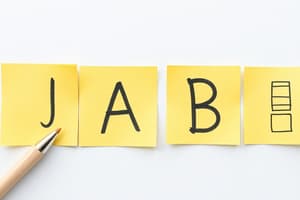Podcast
Questions and Answers
What is the first piece of information required in a formal letter's header?
What is the first piece of information required in a formal letter's header?
- The signature of the sender
- The greeting
- The sender's address (correct)
- The date of the letter
Which title should be used in the greeting if the recipient's name is unknown?
Which title should be used in the greeting if the recipient's name is unknown?
- To Whom it May Concern (correct)
- Dear Employee
- Hey There
- Dear Sir or Madam
What key information should be included in the body of a formal letter?
What key information should be included in the body of a formal letter?
- A summary of the letter sender's life
- Requests or information related to the purpose of writing (correct)
- Detailed complaints about previous services
- Personal anecdotes unrelated to the topic
Which of the following is the correct closing signature format?
Which of the following is the correct closing signature format?
How many lines should be left empty before typing the greeting in a formal letter?
How many lines should be left empty before typing the greeting in a formal letter?
What information is essential to include in the sender's address?
What information is essential to include in the sender's address?
What is the purpose of the closing in a formal letter?
What is the purpose of the closing in a formal letter?
Which element should NOT be included in the formal letter's body?
Which element should NOT be included in the formal letter's body?
What is a primary purpose of commercial correspondence?
What is a primary purpose of commercial correspondence?
Which of the following is NOT an element of a good letter?
Which of the following is NOT an element of a good letter?
What should be prioritized in a CV?
What should be prioritized in a CV?
Which type of letter is considered more formal?
Which type of letter is considered more formal?
What is a key element to consider when writing to an audience?
What is a key element to consider when writing to an audience?
Which feature of business letters contributes to their importance?
Which feature of business letters contributes to their importance?
What is the purpose of a personal profile in a CV?
What is the purpose of a personal profile in a CV?
What is an example of a function of a business letter?
What is an example of a function of a business letter?
In which order should the Education section be presented in a CV?
In which order should the Education section be presented in a CV?
Which of the following is typically NOT a characteristic of a well-structured CV?
Which of the following is typically NOT a characteristic of a well-structured CV?
What is essential to include when listing skills in a CV?
What is essential to include when listing skills in a CV?
Which of the following is typically included in the Additional Information section of a CV?
Which of the following is typically included in the Additional Information section of a CV?
Why might someone choose to have two separate Experience sections in their CV?
Why might someone choose to have two separate Experience sections in their CV?
What information is typically excluded from a CV?
What information is typically excluded from a CV?
Where is the name generally placed in a CV layout?
Where is the name generally placed in a CV layout?
What should the Interests and Achievements section primarily convey?
What should the Interests and Achievements section primarily convey?
What is the main purpose of a friendly letter?
What is the main purpose of a friendly letter?
Which element is typically included in the conclusion of a friendly letter?
Which element is typically included in the conclusion of a friendly letter?
How does the format of a friendly letter differ from that of a business letter?
How does the format of a friendly letter differ from that of a business letter?
What is the appropriate way to start a friendly letter?
What is the appropriate way to start a friendly letter?
In a business letter, where should the sender’s signature be placed?
In a business letter, where should the sender’s signature be placed?
What should be included in the introductory paragraph of a friendly letter?
What should be included in the introductory paragraph of a friendly letter?
What is the recommended spacing before the date in a business letter?
What is the recommended spacing before the date in a business letter?
What is one key difference between friendly and business letters?
What is one key difference between friendly and business letters?
Flashcards
Profile
Profile
A personal statement that highlights your key skills and experience relevant to the job you are applying for.
Education
Education
A section that lists your educational qualifications in reverse chronological order, starting with the most recent.
Experience
Experience
A section that lists your work experience in reverse chronological order, starting with the most recent.
Skills
Skills
Signup and view all the flashcards
Additional Information
Additional Information
Signup and view all the flashcards
Interests and Achievements
Interests and Achievements
Signup and view all the flashcards
References
References
Signup and view all the flashcards
General CV Layout
General CV Layout
Signup and view all the flashcards
Letter
Letter
Signup and view all the flashcards
Date of Letter
Date of Letter
Signup and view all the flashcards
Recipient
Recipient
Signup and view all the flashcards
Salutation
Salutation
Signup and view all the flashcards
Body of the Letter
Body of the Letter
Signup and view all the flashcards
Closing
Closing
Signup and view all the flashcards
Signature
Signature
Signup and view all the flashcards
Typed Name
Typed Name
Signup and view all the flashcards
Business Letter
Business Letter
Signup and view all the flashcards
External Correspondence
External Correspondence
Signup and view all the flashcards
Internal Correspondence
Internal Correspondence
Signup and view all the flashcards
Clear and Concise Letter
Clear and Concise Letter
Signup and view all the flashcards
Professional Letters
Professional Letters
Signup and view all the flashcards
Letter Heading
Letter Heading
Signup and view all the flashcards
Letter Closing
Letter Closing
Signup and view all the flashcards
Letter Body
Letter Body
Signup and view all the flashcards
Friendly Letter
Friendly Letter
Signup and view all the flashcards
Introduction (Friendly Letter)
Introduction (Friendly Letter)
Signup and view all the flashcards
Message (Friendly Letter)
Message (Friendly Letter)
Signup and view all the flashcards
Conclusion (Friendly Letter)
Conclusion (Friendly Letter)
Signup and view all the flashcards
Expressing Gratitude
Expressing Gratitude
Signup and view all the flashcards
Informal Writing Style
Informal Writing Style
Signup and view all the flashcards
Friendly Letter Writing
Friendly Letter Writing
Signup and view all the flashcards
Study Notes
Curriculum Vitae (CV)
- CVs have several main sections
- Not all sections are necessary
- Choose sections based on the job's requirements (skills, education, experience)
- Format: professional looking
CV Components
- Name: Large, bold font
- Address: Full physical address
- Phone/Mobile: Contact information
- Email: Professional email address
Profile
- 3-5 lines needed
- Similar language to the employer's job description
- Reflects applicant's goals and the specific job
- Original and specific details
Education
- Listed in reverse chronological order (most recent first)
- Include: University/College/School Name, Dates
Experience
- Listed in reverse chronological order
- Consider creating separate sections for "Relevant" and "Other" experience
- Include: Employer name, Dates, Job title, Responsibilities
Skills
- Emphasized in "Skills-based" CVs
- Provide clear examples demonstrating skills that match job requirements and employer specifications
Additional Information
- Includes employer-requested details (driving license, work permits, computer literacy)
Interests and Achievements
- Showcases the applicant's personality
- Includes: memberships, responsibilities, awards, prizes, scholarships
References
- If space allows, include full contact information for two professional referees (typically previous managers)
Notes: Additional Information
- Include publications, conferences, and related training sessions
- Option to include personal information like date of birth, nationality, marital status, gender, number of children
- Add a photo to the upper right corner only if requested by the employer
CV Summary
- Easy to read, organized, logical, and clear
- Focused on the specific job opportunity
- Prioritize important details at the beginning of the CV
- Positive and free of spelling mistakes
Letters' Writing
Types of Letters
- Commercial correspondence (Business letters): Used for communication with external parties in business transactions
- Friendly letters: Used for personal communication with acquaintances
- Company internal correspondence (Internal notes): For internal communication within a company
Commercial Correspondence (Business Letters)
- Communication between external parties during a transaction
- Crucial for written documentation and reflects the intent of the parties.
- A critical part of business operations
- Can be formatted as informational, persuasive, motivational, or promotional
Uses of a Business Letter
- Formal method of communication between two or more parties
- Can be informational, persuasive, motivational, or promotional
- Possible uses include: explaining why you want a job, expressing dissatisfaction with a service, asking for information, conveying an opinion to government.
Importance of Letters
- Represent company image and competence
- More personal than a report, yet more formal than email
- Official legal record of agreements
- Provide wide-ranging corporate information
Elements of a Good Letter
- Understanding the recipient's background and avoiding overly technical jargon essential for effective communication
- Clear and concise presentation of the objective of the letter, avoiding ambiguity
- Maintaining professionalism, even in complaint letters, through politeness and a focus on the problem itself.
Parts of a Letter
- Address: Sender's address
- Date line: Date of writing
- Inside address: Recipient's address
- Salutation: Greeting (e.g., Dear Mr./Ms./Ms.)
- Body: Main content of the letter
- Complementary close: Closing (e.g., Sincerely)
- Signature: Handwritten signature
- Enclosure(s): Indication of any enclosed documents
Friendly Letter Writing
- Less formal than business letters
- First paragraph to introduce and summarize the main topic
- Introductions in letters to unfamiliar recipients
- Following paragraphs deliver the message with necessary details
- Final paragraph concludes the correspondence.
Studying That Suits You
Use AI to generate personalized quizzes and flashcards to suit your learning preferences.




